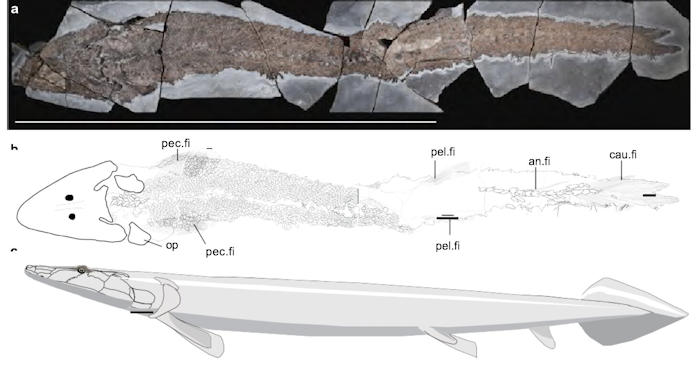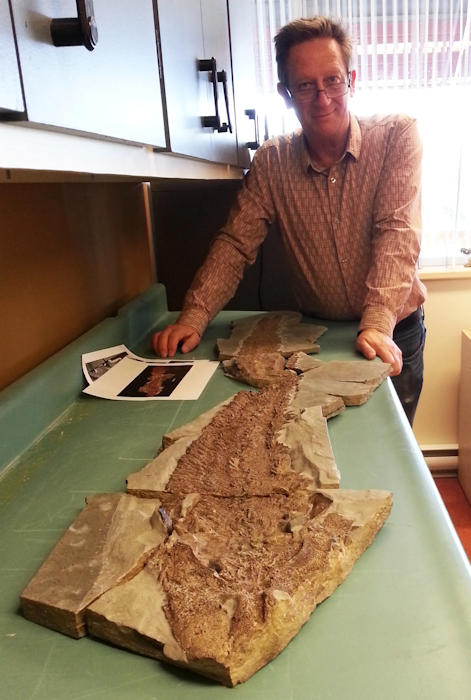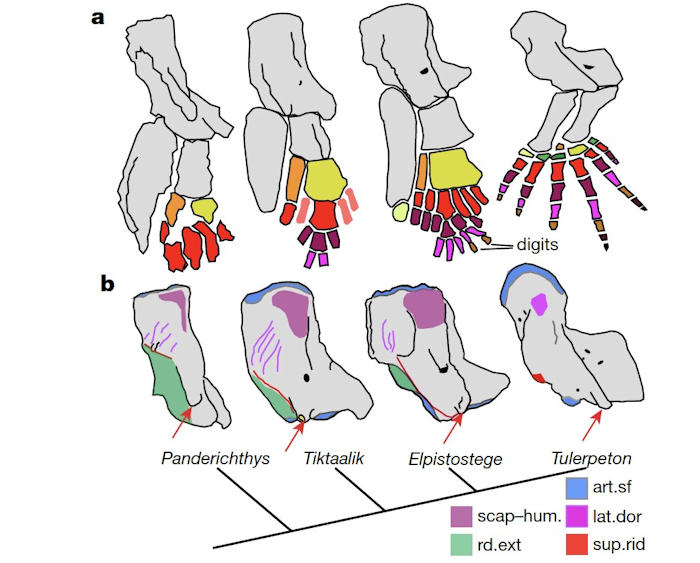Jan Bartek – AncientPages.com – What can human hands possibly have in common with fish fins? Not much, most would say. However, according to scientists, fossil evidence offers remarkable insight into how the human hand evolved from fish fins.
The study is based on examining an ancient Elpistostege fish fossil found in Miguasha, Canada.

Complete specimen in dorsal view. Scale bar, 1 m. b, Camera lucida drawing of the postcranial anatomy of the specimen; pectoral fins have been illustrated in their position, although they are only visible ventrally. c, Reconstruction. an.fi, anal fin; cau.fi, caudal fin; op, opercular; pec.fi, pectoral fin; pel.fi, pelvic fin. Credit: Nature
Paleontologists from Flinders University in Australia and Universite du Quebec a Rimouski in Canada have revealed the fish specimen has yielded the missing evolutionary link in the fish to tetrapod transition, as fish began to foray in habitats such as shallow water and land during the Late Devonian period millions of years ago.
This complete 1.57 metre-long fish shows the complete arm (pectoral fin) skeleton for the first time in any elpistostegalian fish. Using high energy CT-scans, the skeleton of the pectoral fin revealed the presence of a humerus (arm), radius and ulna (forearm), rows of carpus (wrist) and phalanges organized in digits (fingers).
According to John Long, Strategic Professor in Palaeontology at Flinders University the discovery of a complete specimen of a tetrapod-like fish called Elpistostege, reveals extraordinary new information about the evolution of the vertebrate hand.
“This is the first time that we have unequivocally discovered fingers locked in a fin with fin-rays in any known fish. The articulating digits in the fin are like the finger bones found in the hands of most animals.”
This finding pushes back the origin of digits in vertebrates to the fish level, and tells us that the patterning for the vertebrate hand was first developed deep in evolution, just before fishes left the water, ” Professor Long said.
The evolution of fishes into tetrapods—four-legged vertebrates of which humans belong—was one of the most significant events in the history of life.
Vertebrates (back-boned animals) were then able to leave the water and conquer land. In order to complete this transition- one of the most significant changes was the evolution of hands and feet.

Professor John Long with the Elpistostege fish fossil found in Miguasha, Canada. Credit: Flinders University
In order to understand the evolution from a fish fin to a tetrapod limb, palaeontologists study the fossils of lobe-finned fish and tetrapods from the Middle and Upper Devonian (393-359 million years ago) known as ‘elpistostegalians’.
These include the well-known Tiktaalik from Arctic Canada, known only from incomplete specimens.
Co-author Richard Cloutier from Universite du Quebec a Rimouski says over the past decade, fossils informing the fish-to-tetrapod transition have helped to better understand anatomical transformations ᴀssociated with breathing, hearing, and feeding, as the habitat changed from water to land on Earth.
“The other features the study revealed concerning the structure of the upper arm bone or humerus, which also shows features present that are shared with early amphibians. Elpistostege is not necessarily our ancestor, but it is closest we can get to a true ‘transitional fossil’, an intermediate between fishes and tetrapods.”

a, b, Comparison of the anatomy of the pectoral limb endoskeleton (a) and humerus (b) of stem-tetrapod fish (Panderichthys,Tiktaalik and Elpistostege) and an early tetrapod (Tulerpeton). Proximodistalrows of radials or digits are shown colour-coded according to the scheme in Fig. 4. Red arrows in b indicate the ectepicondyle. Panderichthys data are fromref. 13; Tiktaalik data are from ref. 4; Acanthostega data are from ref. 26;Tulerpeton data are from ref. 31. Images in b are modified from ref. 49. art.sf,articulation surfaces; lat.dor, attachment ridges for latissimus dorsi muscles;sup.rid, supinator ridge; rd.ext, attachment area for radial extensors; scap-hum., attachment area for scapula and humeral muscles. Credit: Nature
Elpistostege was the largest predator living in a shallow marine to estuarine habitat of Quebec about 380 million years ago. It had powerful sharp fangs in its mouth so could have fed upon several of the larger extinct lobe-finned fishes found fossilised in the same deposits.
Elpistostege was originally named from just a small part of the skull roof, found in the fossiliferous cliffs of Miguasha National Park, Quebec, and described in 1938 as belonging to an early tetrapod.
Another part of the skull of this enigmatic beast was found and described in 1985, demonstrating it was really an advanced lobe-finned fish. The remarkable new complete specimen of Elpistostege was discovered in 2010.
The study was published in the journal Nature
Written by Jan Bartek – AncientPages.com Staff Writer





